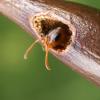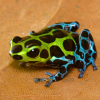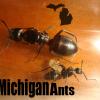I'm not sure if I understand completely as I'm kind of dumb and slow learning. So, hopefully this helps and is on topic for what you are looking for.
So, I'll go by my own ant species I have and have had. I'll ignore access to food/water and what not that they have in captivity that they don't have as easily outside.
My Pogonomyrmex subnitidus colony I'd say meets this model. Where they live outside, they do about as good at 90 degrees (how hot our garage gets (on average) in the Summer and hotter days) as they do outside. Their brood production goes fastest when the outside temperature is warmer, resulting in a warmer garage. But, this is pretty typical of even the outside colonies. When the colonies locally, here fly, its on hot, sunny warm days that get up to 100 degrees out in the day time (but I believe they fly in the evening on warmer afternoons). Pogonomyrmex californicus tend to fly out in the Salton Sea (southeast of Palm Springs) on 100+ degree temperature (it gets up to 123 degrees there). So, the optimal temperature if I get what you are saying, is actually the same as when they have their mating flights outside from what I noticed. I have the heat lamp on them, so add that 90 and maybe another 5-10 degrees and it ends up actually being the same as the outside temperature on hot summer days.
The Camponotus I've had that I've found up in the mountains, seem to also have this optimal temperature. In the mountains where I usually have found queens, its about 75-80 degrees in the actual forest (of course, out in open areas its going to be hotter). Except, if I kept them at 90 degrees like Pogonomyrmex (let alone 100, that be WORSE), I actually noticed the workers die faster and I'll just find them dead even if they have access to water. I guess that could be caused by other reasons, but this has happened a few times. Actually, every Camponotus queen up till the ones Drew gave me (which I keep in a dark area of the garage), the workers and brood quickly disappear after it hits 90 degrees or drops below 70. Which poses a problem for me with Camponotus, as the garage is always warmer and inside the apartment is a lot colder. However, if I keep them at room temperature (65-70 degrees, so a bit below forest temperature)...their brood development slows WAY down to a near stop and it takes 6 months just to get workers. If they already have workers, if my parents keep it even cooler, the worker(s) just end up dead for some reason. Like I said, could be other reasons. So, the optimal temperature is actually probably 80 degrees, which is very close to about when I find the queens (during monsoon season I usually find them a lot). I find for Camponotus, keeping them in a darker area of the garage works out a lot better for them...if I keep them close to the fan in the garage (but away from any light source) they do better and I took the temperature and it was 84.8 degrees.
So I'd say yeah, your theory is actually correct (at least for the above two). Since I've found Camponotus flying at about 80 degrees (it registered 83 degrees in the car thermometer) and that is (from what I personally have found) them being their best temperature to keep them at. Same with Pogonomyrmex, except they like it a lot hotter than Camponotus.
Then there is the two weird species, Dorymyrmex bicolor and Pheidole hyatti. I am not sure on those. I don't really think they play a part in your model/theory for this particular thing. They probably deserve their own model/theory. 
D. bicolor and P. hyatti have weird brood production in captivity. My Pheidole hyatti at room temperature (cooler than outside definitely, but kept near the window)...STILL produced VASTLY more brood than they EVER do outside. No matter what the temperature is. And my Dorymyrmex bicolor at any temperature, produced vastly more brood than they ever do outside. Its possible for them, that when taken into captivity with vastly extra supply of resources plays a part or they turn "invasive" so to speak. Because Pheidole hyatti never produce thousands of brood in any of their nests (most I've seen is about 100 brood of various stages), but in captivity in a mere week produce...thousands of eggs.
























